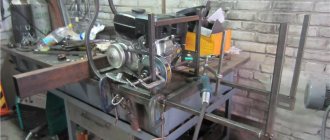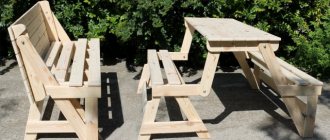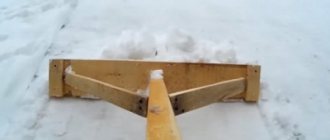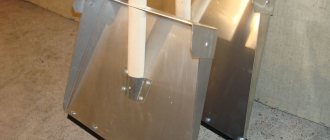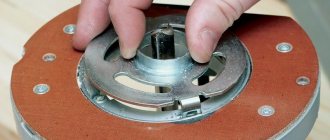“...Oh, the white ship...” Who would refuse a romantic walk along the river or a cruise on a luxury liner? The wind in your hair, fresh river or sea air... Beauty, and that’s all!!! But not everyone can afford such pleasure. How else can you diversify your summer weekend if there is a body of water in the immediate vicinity? The answer is simple: build a raft and float down the river on it. Moreover, the construction of a raft does not require any special engineering knowledge or expensive materials. It is enough to remember the basic rules and look around. There may be visible or invisible building materials around. What are we talking about? Let's explain now.
You can build a rafting raft from plastic bottles
As is already becoming clear, the building material here is ordinary plastic bottles. Their number is determined by how many people you expect to build your raft. The fewer people, the fewer bottles. But let's turn to the instructions directly. Let us immediately note that this is an option for building the simplest raft; You can always make your design fantasies come true.
How to build a raft with your own hands from plastic bottles
Adviсe:
- Firstly, plastic bottles need to be very meticulously and scrupulously examined for holes and holes. Why do this, I think, there is no need to explain.
- Secondly, screw the cap of the bottle tightly, which must be filled with air. This increases the raft's buoyancy.
Instructions:
- Using waterproof tape, we make a block of four bottles. This amount of plastic containers is optimal, because if damaged, the unit can be easily replaced.
- Wrap them with tape as tightly as possible to each other so that the raft does not fall apart. The number of blocks is again determined by the carrying capacity of the raft.
- Next, the blocks are tied into sections, which are formed along the width of the structure.
- The sections are already connected to each other to form the raft itself.
- Next we make the deck of the raft. There is no way without it; passengers with their belongings will be accommodated on it. We make the base from two wooden boards, the length of which should be equal to the length of the raft.
- We fasten the boards on top, across the first two. The distance between them is 40-50 cm. We attach some of the raft bottles to them using a rope and waterproof tape. To make it even more comfortable to be on deck, cover the bottom of the raft with plywood and place a tarpaulin on top. This will help prevent things from getting wet.
You can build a raft for children. A homemade raft that can be launched in streams or a rubber pool is very easy to make from a piece of cardboard and two plastic bottles.
Construction technology
Building a raft from logs is quite easy. Almost anyone with some carpentry skills can make a watercraft with their own hands.
Required tools and materials
In the process of building a boat from logs, you cannot do without the following woodworking tools:
- axe;
- hammer;
- saw;
- sharp knife.
To build a raft from logs you will need an ax.
You will also need to purchase fastening elements:
- vines;
- nails;
- ropes.
The materials used are:
- dry logs;
- wooden beams.
For flooring, you can take plywood, boards or bark.
Installation of logs
It is best to construct a raft near a body of water, since the structure, especially for a large number of people, can be very heavy.
To make a simple raft yourself you need:
- Place the selected logs near the water so that the thin material is in the middle and the thicker material is at the edges. This placement will increase the strength of the entire structure.
- Install wooden beams across the top. You can secure them with nails, vines, or tie them with ropes pre-soaked in water. The beams are fixed both above and below the logs laid in a row. In this case, you should carefully ensure that there are no cracks or gaps in the structure. The cross beams should be slightly longer than the logs.
Technology for building a raft from logs
After this, the steering mechanism is attached and, if necessary, small fences are installed along the edges of the craft.
You can also secure the logs with special steel staples. In this case, the construction of a frame base is not required.
Fastening the deck
The flooring is mounted on already fixed logs. Sheets of selected material are attached so as to create a flat, smooth surface.
Launching the raft
When building a raft near a body of water, it is quite easy to release its water. It is recommended to start laying out logs at the same level as the shore. This will allow you to easily move the craft to the river.
The easiest way to launch a raft is built on supports located parallel to the bed of the reservoir. Such a structure should simply be rolled into the river.
How to make a raft from barrels with your own hands
Another option that is not very labor intensive is a raft made from barrels. We are, of course, not talking about iron or metal tanks, but about light plastic barrels with a volume of 200-250 liters. The barrels here will serve as an air cushion for the raft; a wooden frame will still need to be attached on top. Where can I get them? If you know auto chemical dealers, I think they will be happy to get rid of useless containers.
Barrel raft
So let's get started.
- First of all, you should seal the seams and openings of the barrels with sealant so that air does not escape from them.
- While the sealant dries, we assemble the frame from the boards. It is usually rectangular in shape, with two additional longitudinal boards closer to the edges. The distance between the edges and these boards should be equal to the diameter of the barrels.
- Our barrels will be attached to these unique “corridors”.
- Next we install the flooring on the frame.
- Then we begin to adjust the barrels. It is best to secure them with a rope, tying them tightly to the deck along the entire length of the raft.
- That's all, the raft is ready.
Small raft for three
You can make a small raft from logs with a diameter of up to thirty centimeters. Its construction consists of the following stages:
- Select even logs about three and a half meters long. All tree trunks cleared of branches and trimmed must be exactly the same size so that when they are laid in a row, a flat surface is obtained.
- Lay two separate logs parallel to the river mouth as guides. Such supports should be fairly even and equal in volume.
- Cut grooves on both ends and sides of the logs. For each log they should be at the same distance from the edge so that when the structure is laid out, one continuous line is formed. The location of the upper grooves should be close to the edge, and the lower ones should be slightly directed towards the middle of the log.
- Wooden lintels are prepared thirty centimeters longer than the width of the laid logs.
- The jumpers are inserted through the grooves first in the lower part of the structure, and then installed on top of the raft.
- The blowing edges of the jumpers are tied with vines or ropes. This fixation is not necessary, since when launched into the water, the wood swells and is firmly fixed in the cut grooves.
For a raft made of logs for three, logs 3-3.5 meters long are needed.
Flooring is laid on top. If desired, supports are made from slats to cover the hut.
How to build a raft with your own hands from wood
The wooden raft is the most popular type of watercraft from this series. Dry coniferous wood is usually used for construction. Collecting material doesn’t really contain any tricks. Cut down trees, stack logs nearby.
Wooden raft
Next comes the fun part - assembling the raft into a single structure.
- Place the logs close to each other on the shore.
- Next, place sticks or poles across, the length of the expected width of the raft.
- Then tie the logs and cross sticks together with strong ropes.
- You can also use vines or other climbing plants for this purpose.
To make it easy to control the raft, it is better to additionally make an oar or rudder, or use a long pole.
Raft design
The wooden raft has a simple structure. Its main components are:
- Pontoons. With the help of such a part, the watercraft floats on the surface of the water. Floating pontoons are made from lightweight material, the density of which is much less than the density of liquid.
- Frame. The base of the raft consists of strong elements installed transversely or lengthwise that help connect all parts of the floating structure. When constructing a frame, its weight and rigidity should be taken into account. Too heavy base parts make the raft inconvenient for launching. The rigidity of the device is necessary to maintain the shape of the frame, on which the integrity of the entire swimming device depends.
- Control mechanism. To direct the raft in the desired direction, adjustment elements such as large oars are installed - rowing, keel or six. The type of control mechanism is selected depending on the depth at which the raft will be used and the current in the reservoir.
- Safety elements. When the raft is moving quickly or when it hits a hard surface, safety devices are required to ensure the safety of passengers. These could be parts of the control mechanism that you can hold on to with your hands or special supports that prevent people from falling into the water.
- Covering the boat. Flooring is not always installed on a raft. This design element is used for the external design of the swimming device and to create comfort. The material used to cover the raft must be strong enough.
- Device for things. Some watercraft are equipped with a special cover in the form of a tent. This device allows you to store things in rainy weather. To prevent luggage from falling into the water, it is tied with ropes.
A raft made of logs with a cover for things.
All valuable items are transported in brightly colored waterproof bags so that they can be easily found even in the river.
What is the Kon-Tiki raft made of?
From the school history course, everyone knows about a traveler named Thor Heyerdahl, who went on a long sea voyage on a raft called Kon-Tiki, which in turn was named after the sun god of the ancient Incas.
Kon-Tiki raft
The wood from which the Kon-Tiki raft was built is called balsa. The raft was built from nine such trees. These logs served as the basis of the raft. On top, Heyerdahl laid the same number of balsa logs, but with a smaller diameter, which became the basis of the deck. And they covered the deck itself with bamboo mats, from which they also built a hut with a roof made of banana leaves. It is noteworthy that not a single nail was used to build Kon-Tiki, only ropes. The mast and rudder were constructed from mangrove wood.
0
Author of the publication
offline 3 years
Nika
18
I am interested in hiking and traveling, photography and videography. I have been going hiking since childhood. The whole family went and went - sometimes to the sea, then to the river, to the lake, to the forest. There was a time when we spent a whole month in the forest. We lived in tents and cooked over fires. This is probably why I am still drawn to the forest and, in general, to nature. I travel regularly. About three trips a year for 10-15 days and many 2 and 3 day hikes.
Comments: 0Publications: 668Registration: 10/23/2018
Nika's Shelter
Selection and preparation of material
Logs are the most common material for building a raft. The tree has excellent floating characteristics. In addition, the material is quite affordable.
The wood for the raft must be:
- dry;
- flat;
- without knots;
- easy.
Wood with a high moisture content does not float well in water. To check the quality of the logs, you should hit them with an ax - sufficiently dry wood makes a ringing sound.
Balsa wood is considered the lightest material. It is completely easy to process. But this breed grows in the tropics. Therefore, dry pine or spruce is most often used. Logs are selected with a diameter of no less than ten and no more than thirty centimeters.
To prepare a tree for a raft, cut off all branches with an ax and inspect for splits and knots. If necessary, the wood surface is leveled.
Overcoming rapids or fast-flowing rivers.
Swimming across a river in places with rapids or fast currents is not as difficult as it might seem. On shallow rapids, lie on your back with your legs pointing downstream, your body lying horizontally, your hands on your hips. Make movements with your hands similar to how a seal works with its flippers.
In deep rapids, swim on your stomach, trying to land on shore whenever possible. Watch for places where currents converge. You may be sucked into the dangerous whirlpools they create.
Based on materials from the book SURVIVAL. Koleda S.I., Drachev P.N.
Discussion
weak... there are more popular instructions
I would like more details
They did this in brain breakers =), +1 for the effort)
Yes, there are not enough details......
Every year we hold a show “swimming” with all sorts of different means! Right now I’ll glue myself a raft and GO to participate!
It seems like you need a lot of bottles, and the raft will be slippery. So much material will be difficult to find, and transportation to the river requires a lot of work.
good instructions, but if I drink so much lemonade, beer and other things, I’ll burst!
Badly!
